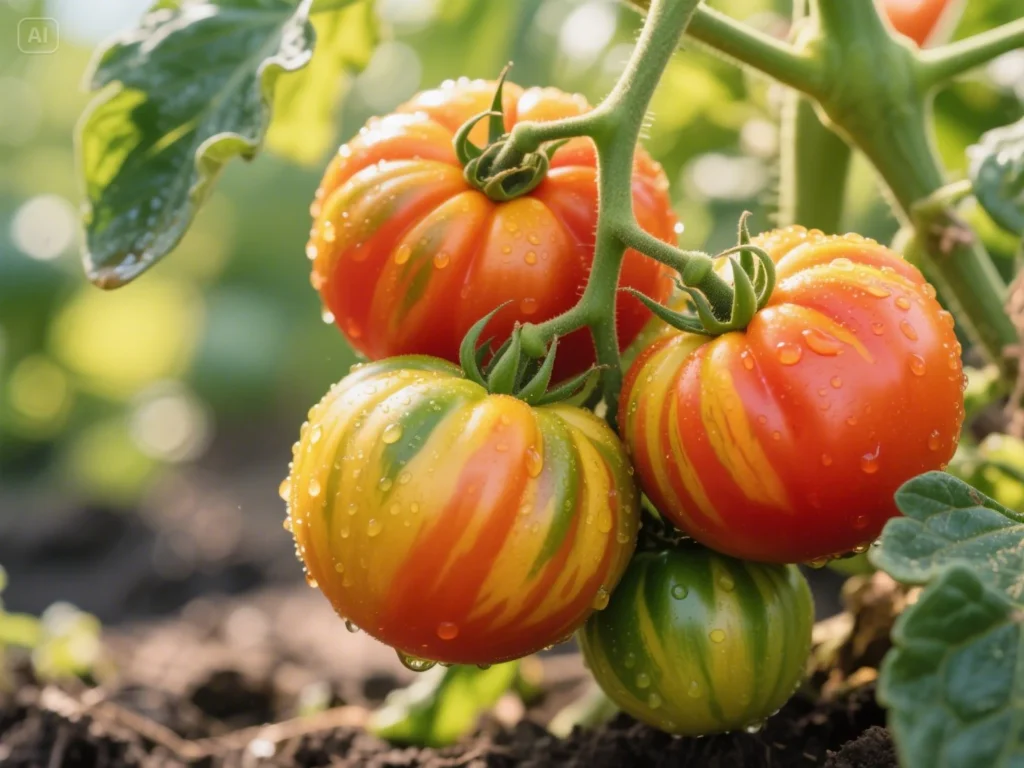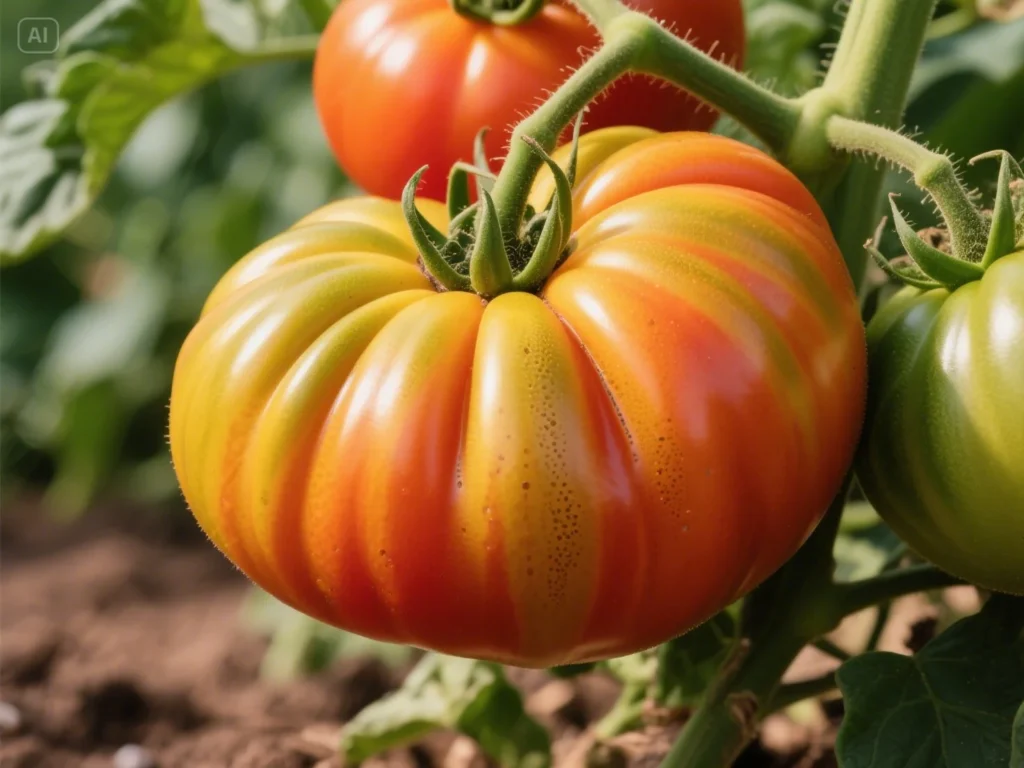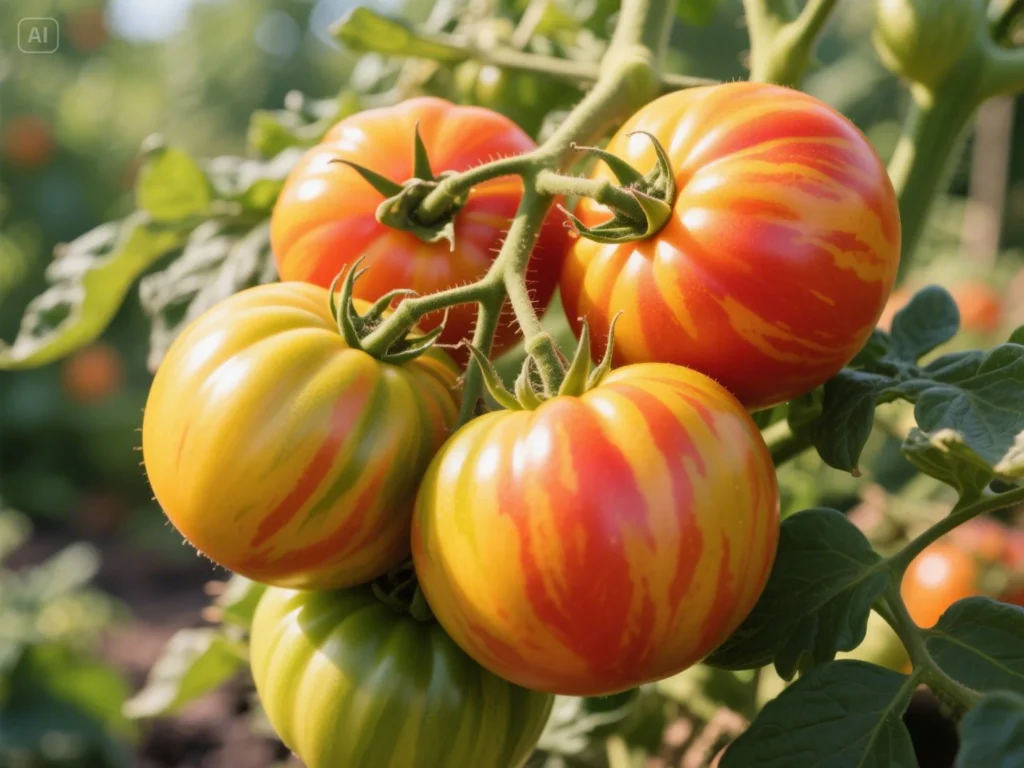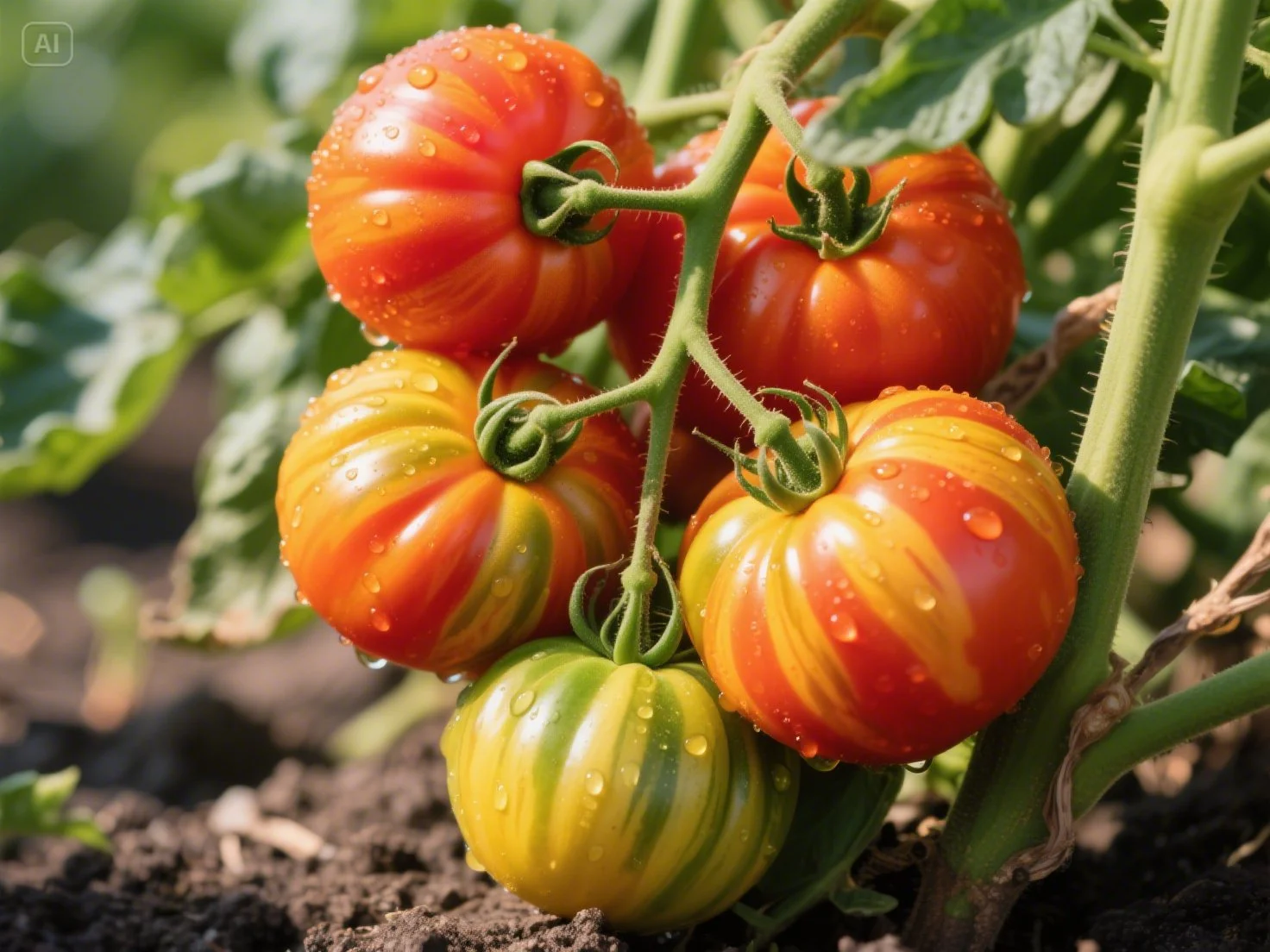Introduction
Picture this: a tomato so vibrant it looks like a sunset, with golden-yellow skin streaked with red, and a flavor so sweet it reminds you of tropical fruit. Meet the Pineapple Tomato, an heirloom variety that’s stealing the spotlight in gardens and kitchens alike.
If you love growing unique, flavorful produce, this tomato deserves a spot in your garden. Unlike standard grocery store varieties, the Pineapple Tomato boasts a striking appearance, low acidity, and a rich, sweet-tangy taste that chefs and home cooks adore. Its name comes not from its genetics (it’s 100% tomato!) but from its tropical flavor and colorful stripes.
In this guide, you’ll discover:
- What makes the Pineapple Tomato special from its heirloom roots to its juicy, beefsteak-sized fruit.
- How to grow it successfully, including soil tips, sunlight needs, and pest fixes.
- Creative ways to enjoy it, think fresh salads, roasted dishes, and crowd-pleasing salsas.
- Where to find seeds or plants, plus solutions to common growing challenges.
Whether you’re a seasoned gardener or a first-time tomato grower, this post will help you unlock the full potential of this standout heirloom. Let’s dig in!
What Exactly is a Pineapple Tomato?

Heirloom Status
The Pineapple Tomato is a true heirloom tomato, meaning it’s been passed down through generations of gardeners for at least 50 years. Unlike hybrid tomatoes, this open-pollinated variety grows from seeds that produce plants identical to the parent. While its exact origins are unclear, many believe it first appeared in Kentucky or West Virginia in the early 20th century. Heirloom tomatoes like this one are treasured for their genetic diversity, rich flavors, and ties to gardening history.
Appearance & Physical Characteristics
This tomato is a showstopper in both size and looks:
- Size: A single Pineapple Tomato often weighs 1–2 pounds, placing it in the beefsteak tomato category.
- Color: Its golden-yellow skin and flesh are streaked with bold red or pink marbling, which deepens near the blossom end.
- Shape: It has a slightly ribbed shape, similar to classic beefsteak varieties.
- Plant Type: As an indeterminate tomato variety, the plant grows on tall, sprawling vines that require sturdy support (like stakes or cages) and produce fruit all season until frost.
Flavor Profile
The Pineapple Tomato’s taste is where it truly shines:
- Taste: Expect a sweet, fruity flavor with subtle tropical notes—no pineapple, but a hint of citrus and honey.
- Acidity: It’s a low-acid tomato, making it milder and gentler on sensitive stomachs compared to many red varieties.
- Texture: The flesh is meaty and dense, with few seeds, perfect for slicing into thick wedges for sandwiches or caprese salads.
This combination of bold looks and balanced flavor makes it a favorite for gardeners and food lovers alike.
Why Grow (or Seek Out) Pineapple Tomatoes?

Exceptional Taste & Low Acidity
If you’ve ever winced at the sharp tang of a standard tomato, the Pineapple Tomato will surprise you. Its sweet, fruity flavor and low acidity make it a hit for anyone who prefers mild, gentle flavors. This tomato won’t overpower dishes or upset sensitive stomachs, it’s perfect for fresh eating straight from the vine.
Stunning Visual Appeal
A sliced Pineapple Tomato turns ordinary meals into eye-catching masterpieces. Its golden-yellow flesh streaked with bold red marbling adds a pop of color to salads, sandwiches, and charcuterie boards. Imagine serving guests a caprese salad with these vibrant slices—it’s a guaranteed conversation starter.
Gardening Satisfaction
Growing Pineapple Tomatoes feels like unlocking a gardening achievement. These plants:
- Produce large, impressive fruits (1–2 pounds each) that feel rewarding to harvest.
- Thrive as indeterminate vines, yielding tomatoes all season long.
- Stand out as a garden centerpiece thanks to their unique looks and vigorous growth.
For heirloom enthusiasts, nurturing this variety connects you to decades of gardening tradition.
Culinary Versatility
While they’re stellar fresh, Pineapple Tomatoes hold up beautifully in cooked dishes. Their meaty texture and balanced sweetness work in salsas, roasted sauces, and even grilled recipes. (We’ll dive into specific ideas in Section 5!)
In short, this tomato offers flavor, beauty, and bragging rights all from one plant.
How to Grow Pineapple Tomatoes: A Practical Guide

Seeds vs. Starts
You can grow Pineapple Tomatoes from seeds or transplants. Starting from seeds offers more variety and lower costs; many reputable seed companies stock them, including Baker Creek and Seed Savers Exchange. Seeds take 6–8 weeks indoors before transplanting. For beginners, buying tomato starts from local nurseries, skips the guesswork. Either way, choose disease-resistant seeds or plants labeled “heirloom” for authenticity.
Planting Conditions
Sunlight: Plant in a spot with 6–8 hours of full sun daily. Less light means smaller harvests.
Soil: Use rich, well-draining soil mixed with compost. Aim for a pH of 6.0–6.8 (test kits are inexpensive).
Spacing: Give each plant 3–4 feet of space to accommodate its sprawling indeterminate growth. Crowding invites disease.
Care & Maintenance
Watering:
- Water deeply 1–2 times weekly, keeping soil moist but not soggy.
- Use a soaker hose or drip irrigation to avoid wetting leaves (reduces fungal risk).
Fertilizing:
- At planting, mix balanced fertilizer (10-10-10) into the soil.
- Switch to low-nitrogen, high-phosphorus fertilizer (5-10-10) once flowers form to boost fruit.
Support:
- Install sturdy tomato cages or 6-foot stakes at planting. Vines grow heavy—thin bamboo won’t cut it.
Pruning:
- Remove suckers (side shoots) below the first flower cluster for larger fruit.
- Trim crowded leaves to improve airflow and deter disease.
Pest & Disease Management:
- Hornworms: Handpick or spray with neem oil.
- Blight: Rotate crops yearly and mulch to prevent soil splash.
- Blossom end rot: Add crushed eggshells to the soil for calcium.
Harvesting Pineapple Tomatoes
When to Pick:
- Look for deep golden-yellow skin with red streaks.
- Gently squeeze ripe fruit gives slightly but isn’t mushy.
- The tomato should twist off the vine easily.
How to Pick:
- Use garden snips or scissors to avoid damaging the stem.
- Harvest in the morning when flavors are most concentrated.
Best Ways to Enjoy Pineapple Tomatoes
The Star: Fresh Eating
The Pineapple Tomato’s sweet, low-acid flavor and stunning looks make it a standout for raw dishes:
- Thick slices: Serve with a sprinkle of flaky salt, cracked pepper, and a drizzle of olive oil. It’s juicy, meaty texture holds up without falling apart.
- Sandwiches: Upgrade your BLT with golden-red slices. The mild sweetness balances salty bacon and crisp lettuce.
- Caprese salads: Layer slices with fresh mozzarella, basil leaves, and balsamic glaze. The color contrast turns this classic into a showpiece.
- Fresh salsa: Dice with cilantro, red onion, and lime for a mild, fruity twist on pico de gallo.
- Bruschetta: Top toasted bread with chopped tomatoes, garlic, and olive oil for a simple appetizer.
Gentle Cooking
While Pineapple Tomatoes shine fresh, their low acidity also works in cooked dishes:
- Mild sauces: Simmer chopped tomatoes with garlic and herbs for a delicate pasta sauce. Add a splash of lemon juice or vinegar if you prefer tang.
- Roasted: Halve tomatoes, drizzle with oil, and roast at 400°F until caramelized. Toss with pasta or spread on crusty bread.
- Quick sautés: Cook sliced tomatoes with zucchini and garlic for a sweet, colorful side dish.
Pro tip: Their dense flesh retains shape when cooked, making them ideal for chunky sauces or grilling.
Where to Find Pineapple Tomatoes
Seeds and Plants
To grow Pineapple Tomatoes yourself, start with quality seeds or plants:
- Online seed companies: Reputable heirloom catalogs like Baker Creek, Seed Savers Exchange, and Territorial Seed Company often carry Pineapple Tomato seeds. Check listings in early spring.
- Local nurseries: Visit garden centers in spring for tomato starts. Call ahead to confirm availability, as heirloom varieties may sell quickly.
- Seed swaps: Join local gardening clubs or online communities (like Facebook groups) to trade seeds. Many gardeners share heirloom varieties like Pineapple Tomato at these events.
Pro tip: Save seeds from your harvest! As an open-pollinated variety, Pineapple Tomato seeds will grow true to type next season.
Fresh Fruit
If growing isn’t an option, hunt for fresh Pineapple Tomatoes at:
- Farmers markets: Visit markets in late summer (peak season). Ask vendors directly, some growers specialize in unique heirlooms.
- Local farms/CSAs: Small farms often grow specialty tomatoes for their CSA boxes or farm stands. Call ahead to inquire.
- Specialty grocery stores: While rare, upscale markets may stock them seasonally. Check produce sections in August or September.
Note: These tomatoes are delicate and rarely shipped long-distance. Your best bet is local growers during harvest season.
Potential Challenges with Pineapple Tomatoes
Like many heirloom varieties, Pineapple Tomatoes require a bit more attention than hybrid tomatoes. But don’t let these minor hurdles deter you; most are easily managed with simple fixes.
Cracking:
Large, juicy fruits like Pineapple Tomatoes are prone to tomato cracking, especially after heavy rain or irregular watering. To prevent splits:
- Water deeply and consistently (1–2 inches per week).
- Add mulch to keep soil moisture steady.
- Harvest slightly underripe tomatoes if storms are forecasted.
Disease Susceptibility:
Heirlooms often lack the disease resistance bred into hybrids. Watch for:
- Early blight: Brown spots on leaves. Remove affected foliage and avoid overhead watering.
- Blossom end rot: Dark, sunken spots on fruit. Caused by calcium deficiency, mix crushed eggshells into the soil at planting.
Pests:
- Hornworms: Handpick these green caterpillars or spray plants with neem oil.
- Aphids: Blast them off with water or use insecticidal soap.
The Bottom Line: These issues are common in tomato gardening, not unique to Pineapple Tomatoes. With basic care, you’ll still reap a flavorful harvest.
5 Mistakes to Avoid When Growing Pineapple Tomato
Growing Pineapple Tomatoes is rewarding, but even seasoned gardeners can stumble. Here are common pitfalls and how to sidestep them:
1. Overcrowding Plants
Pineapple Tomatoes need space. Planting them too close (less than 3–4 feet apart) limits airflow, increases disease risk, and reduces fruit size.
Fix: Follow spacing guidelines and prune lower leaves for better circulation.
2. Inconsistent Watering
Uneven watering causes tomato cracking and blossom end rot. Dry spells followed by heavy watering shocks the plant.
Fix: Water deeply 1–2 times weekly. Use mulch to lock in moisture.
3. Skipping Support Structures
These indeterminate vines grow tall and heavy. Flimsy stakes or no support lead to snapped stems or fruit touching the ground.
Fix: Install sturdy 6-foot stakes or heavy-duty cages at planting time.
4. Ignoring Soil Prep
Poor soil = poor harvests. Pineapple Tomatoes thrive in nutrient-rich, slightly acidic soil.
Fix: Mix compost into beds before planting. Test soil pH and add lime if too acidic (below 6.0).
5. Letting Pests Go Unchecked
Aphids and hornworms love tomato plants. Ignoring early signs can devastate your crop.
Fix: Check leaves weekly. Remove pests by hand or use organic sprays like neem oil.
Avoid these mistakes, and you’ll maximize your chances of a healthy, flavorful harvest.
Conclusion
The Pineapple Tomato is more than just a plant, it’s a garden gem that offers striking beauty, sweet, low-acid flavor, and the joy of growing a piece of gardening history. Whether you’re drawn to its sunset-like stripes, its juicy beefsteak slices, or the satisfaction of nurturing an heirloom variety, this tomato delivers on every front.
Why give it a try?
- Unique flavor: Perfect for those who find traditional tomatoes too tangy.
- Garden appeal: A vigorous grower that becomes a focal point in any plot.
- Culinary versatility: Equally dazzling fresh or cooked.
Even with minor challenges like cracking or pest management, the rewards far outweigh the effort. Imagine biting into a tomato you’ve grown yourself, one that’s as flavorful as it is beautiful.
Ready to start?
- Share your story: Have you grown or tasted Pineapple Tomatoes? Tell us in the comments!
- Explore more: Check out our guides on [Heirloom Tomato Varieties] or [Organic Pest Control Tips].
- Spread the love: If this post inspired you, share it with fellow gardeners!
Here’s to a vibrant, delicious harvest. Happy growing!
FAQs
Are Pineapple Tomatoes determinate or indeterminate?
Pineapple Tomatoes are indeterminate, meaning they grow on tall, sprawling vines that produce fruit continuously until frost. Plan for sturdy stakes or cages to support their growth.
What do Pineapple Tomatoes taste like?
They have a sweet, fruity flavor with subtle tropical notes and low acidity, making them milder than many red tomato varieties. Think of it as a “gateway tomato” for those who dislike sharp, tangy flavors.
How big do Pineapple Tomatoes get?
These are beefsteak-type tomatoes, often weighing 1–2 pounds each. Their large size and meaty texture make them ideal for slicing into sandwiches or salads.
When are Pineapple Tomatoes ready to pick?
Look for deep golden-yellow skin with red streaks and a slight softness when gently squeezed. Ripe tomatoes detach easily from the vine. Don’t rely on color alone!

0 thoughts on “Pineapple Tomato: Everything You Need to Know Now”